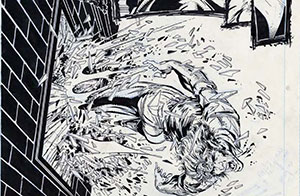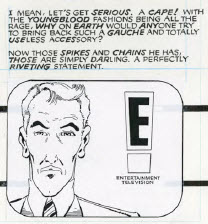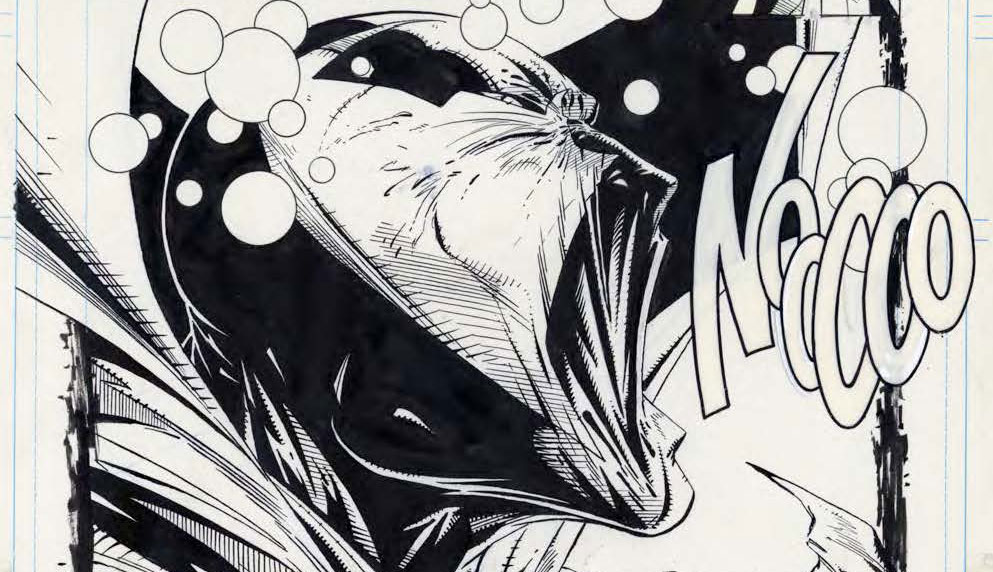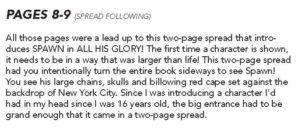In the latest sign that you’re totally old, no matter how fresh of a hoodie you’re rocking with your beaten-up jeans, the “new” superheroes that were spawned (sorry) when Marvel’s top artists bolted for greener, creator-owned pastures in 1992 have been around longer now than The Vision had when they were created. To celebrate that fact, Todd McFarlane has released a “Director’s Cut” of Spawn #1, featuring the “original” art pages in black and white, and commentary from writer/artist/creator McFarlane himself.
That seemed like a Roundtable-worthy occasion, but Jeff is out of commission. So Graeme and Matt decided to have a two-person Roundtable (also known as “a table”) on this momentous occasion.
Time for a Roundtable celebrating 25 YEARS OF SPAWWWWWWWWWWNNNNNNNNNN! [metal guitar lick]
MATT: I remember biking to the comic store and buying Spawn #1 off the shelf–yes, honest, swear-to-god-it’s-not-Spielberg bicycling, as my driver’s license was still a few months away, and they had just punched through a gorgeous, clean stretch of jet-black asphalt connecting my neighborhood to the nearest commercial strip. I didn’t love the story–more on this later, I’m sure–but was of exactly the right age to love McFarlane’s kinetic, twisty expansion on Michael Golden’s gorgeously cartoony art style.
I stuck with it through the first year or so (that’s where I first found the more commercially accessible incarnations of Alan Moore and Neil Gaiman) and then moved on to other things for a couple of years. (Turns out that when you start driving, there are other places to go besides the nearby comic store.) I never really returned to the character longterm, dipping in occasionally when a guest creator did something with the line (Moore’s weird fixation on the Violator family of characters, his Days of Future Past riff in a WildC.A.T.S. crossover, Grant Morrison’s two-issue stint, Gaiman’s Angela miniseries, etc.), but this Director’s Cut was a powerful nostalgia punch for me.
But Graeme, you come at this thing very differently, yeah?
GRAEME: That’s putting it mildly; this was actually the first time that I’d ever read Spawn #1. Or, unless I’m very much mistaken, an issue of Spawn that Todd McFarlane both wrote and drew. I can’t work out if that makes me a snob, philistine or just plain old.
It’s that last one that explains this particular gap in my reading; I was just too old to get into Spawn, or any of the original Image comics, when they were first launched. I have nostalgia for McFarlane’s Hulk with Peter David, and even Rob Liefeld’s Hawk & Dove (Karl Kesel, your inks made that book look very different, I suspect), but I wasn’t even around for Jim Lee’s X-Men. In fact, I’m pretty sure that his first issue — #248, unless I’m misremembering — was my last as a regular X-Men reader, all the way until Grant Morrison took over more than a decade later. I was too busy reading DC titles, and especially the proto-Vertigo books, at the time.
I did pick up the Lee/Claremont X-Men #1-3, as well as Liefeld’s X-Force #1, because they were such a big deal, but I’d be lying if I said I really enjoyed them. McFarlane, meanwhile, I was pretty much bored by. His Amazing Spider-Man with David Micheline didn’t do much for me, and I avoided his solo Spider-Man altogether. So, unsurprisingly, I stayed off the Spawn train, at least until the Alan Moore-written issue. (Or was Sim first? It went Moore/Gaiman/Sim, right?) I didn’t even stay on past those guest-written issues. I’m pretty sure that my Spawn reading numbers in single figures in terms of issues, to this day.
Which is to say: Spawn is an almost entirely unfamiliar beast to me. Which made this anniversary “Director’s Cut” edition a particularly strange read: Do I read the actual comic pages and ignore the commentary, in order to get the full story, or do I read it as it appears, to get the full effect? Will either one be satisfying? (Spoilers: No.)
I’m genuinely curious, from someone who did read this way back in the day: how did this read to you, today? I don’t mean the contemporary McFarlane’s additions, but the original core comic. Coming at it fresh, it seemed almost parodic in how thin it was. Did you get bathed in the warm glow of nostalgia, though?
 MATT: It was… weird. I didn’t remember the book at all, to be honest, or at least not in any sequence. Some of the images stuck with me, but none of the text and none of how they fit together. (One of McFarlane’s commentary anecdotes is about how he would just lay the drawn pages down on the floor and shuffle them around to see what order they worked in, and hoo boy does it ever read like it.)
MATT: It was… weird. I didn’t remember the book at all, to be honest, or at least not in any sequence. Some of the images stuck with me, but none of the text and none of how they fit together. (One of McFarlane’s commentary anecdotes is about how he would just lay the drawn pages down on the floor and shuffle them around to see what order they worked in, and hoo boy does it ever read like it.)
The glow of nostalgia was dimmed somewhat (pun sheepishly intended) by the loss of the colors. A big part of what made this book look unique at the time–and, if we’re being honest, cutting-edge and cool to my 15 year-old eyes–was the glossy luminescent coloring by, I believe, Steve Oliff. Losing that saps a lot of what I remembered most.
But it doesn’t make the art worse by any means. I don’t know if it’s nostalgia or bad taste, but I was surprised by how much I enjoyed McFarlane’s work. I’ve been reading a lot of early-nineties X-books lately, trying to get ahead of Jay and Miles a bit for whenever they come off hiatus, and so much of that art doesn’t hold up at all, but this still clicked for me.
 Not only because of the kineticism and lively cartoonishness I liked at the time, but because you can really see where he’s (at best) influenced by or (more likely) openly aping Frank Miller’s stuff, in scale and use of shadows, or Alan Moore’s pacing and scene transitions. It feels like he’s much more fundamentally sound than Liefeld ever was, and like he’s much more willing to push himself and try to do something a little different.
Not only because of the kineticism and lively cartoonishness I liked at the time, but because you can really see where he’s (at best) influenced by or (more likely) openly aping Frank Miller’s stuff, in scale and use of shadows, or Alan Moore’s pacing and scene transitions. It feels like he’s much more fundamentally sound than Liefeld ever was, and like he’s much more willing to push himself and try to do something a little different.
Is this just me being easy-mark middlebrow guy again, or did you have any positive reaction to McFarlane’s art?
GRAEME: I’ve got to be honest: McFarlane’s art has never worked for me. It’s always seemed too busy, and his quirks — which I can see working for fans, they’re clearly intentional stylizations as opposed to weaknesses in his work (a la Liefeld and feet) — just aren’t to my taste. What’s most surprising about looking at this issue now is seeing how much of an influence McFarlane was on today’s Greg Capullo. That only makes sense, Capullo worked on Spawn for years, but there were multiple points throughout this issue where I could draw a straight line from what’s on the page here to Capullo’s Batman run, far more than I could see Golden’s work in McFarlane’s.
 Of course, that’s not all that’s going on on the page — it was fun to see McFarlane’s commentary about “creating” the reporter page expository technique, as if he hasn’t just lifted it wholesale from Miller, and the places where Spawn is flashing back to his origin contains a lot of appropriately Liefeldian touches, while some pages have a very Perez influence, as well. (The page that starts with the caption “DAMN his lies,” especially.)
Of course, that’s not all that’s going on on the page — it was fun to see McFarlane’s commentary about “creating” the reporter page expository technique, as if he hasn’t just lifted it wholesale from Miller, and the places where Spawn is flashing back to his origin contains a lot of appropriately Liefeldian touches, while some pages have a very Perez influence, as well. (The page that starts with the caption “DAMN his lies,” especially.)
You’re right about the loss of colors really impacting the book — not that I’m familiar with Oliff’s colors, but seeing McFarlane in black and white, so many more of his influences right there, obviously.
Certainly, the art is the draw for the issue. I mean, I quite believe the story about shuffling the pages around after-the-fact, because the writing in this issue is, top to bottom, a complete mess. On every single level, this book makes no sense in terms of writing. I cannot believe that any fan back in 1992 finished this issue and thought to themselves, “What a compelling, well-told story that was.”
I mean, even ignoring the fact that McFarlane’s dialogue is… not very good (Or, as one of his characters would doubtlessly put it, “Even IGNORING?! The fact that his DIALOGUE is NOT VERY GOOD? Who is HE? Why can’t I REMEMBER?! What is… DIALOGUE anyway?”), there’s absolutely no flow to the story. For all that 2017 McFarlane writes commentary about wanting to build visual peaks into the comic, it’s clear that he really, really didn’t give that much of a shit about trying to create something that’s a good read. Was the target audience for this comic just entirely disinterested in writing, or am I being too harsh?

MATT: You are not! But what you are forgetting is that the writing was being most directly compared to the writing Jim Lee and his childhood pals were doing in WildC.A.T.S. (which was derivative and dull) and the writing Rob Liefeld and HIS childhood pals were churning out in Youngblood (which was awful beyond all reckoning). By that comparison, this stuff is Chris Claremont in his prime.
GRAEME: And then there’s the commentary, which I’ll admit was the most interesting thing about the entire comic for me. I’ve had the pleasure of interviewing Rob Liefeld, and the commentary here really reminded me of that experience: the utter confidence on show, and the lack of any second guessing the idea that they have entirely revolutionized comics and changed the game forever. I’m very cynical about the whole “God grant me the ego of a mediocre white man” thing, because I am a mediocre white man and my ego is shit, but reading McFarlane reminisce about his greatness here really reminded me that some people have the self-confidence of giants, whether or not it’s actually earned.
In a terrible way, I loved seeing him visibly get excited when writing things like “All those pages were a lead up to this two-page spread that introduces SPAWN in ALL HIS GLORY!” (Especially when he adds, “This two-page spread had you intentionally turn the entire book sideways to see Spawn!” Were many readers unintentionally turning their comic book sideways back in the ‘90s? I don’t remember that.) And then there are bits that seemed as if they were written to seem ridiculous. “The reason ‘he’s back’ is because of the woman he loves (Wanda) and more importantly, that he died. It’s a shocking moment for him to realize that,” is a stroke of gleeful idiocy. It made me imagine a Mystery Science Theater 3000 where they’re not making fun of the movie, but really into it while also not quite understanding what’s happening onscreen.
 MATT: Ha, the analogy I had been thinking was that it was like a DVD commentary in which the director literally just describes what’s happening onscreen. “Now you see, what we have here is Darth Vader and Obi Wan seeing each other. Now they’re lighting their lightsabers–that’s so they can fight!”
MATT: Ha, the analogy I had been thinking was that it was like a DVD commentary in which the director literally just describes what’s happening onscreen. “Now you see, what we have here is Darth Vader and Obi Wan seeing each other. Now they’re lighting their lightsabers–that’s so they can fight!”
This is, by a reasonably wide margin, the most useless commentary I have ever seen attached to anything. McFarlane manages to strike a tone of mildly proud cluelessness while saying literally nothing of any substance at all, much like he did in the actual comics themselves.
McFarlane clearly knew he was still learning as a writer, and arguably the biggest impact this comic made came when he admitted that and brought in Moore, Gaiman, Sim and Miller to do their four issues. Reading that Alan Moore issue–still with McFarlane’s art–after seven issues of this incoherent rambling was EYE-OPENING. Same for Gaiman. (Less so for Sim, who used his issue as a harangue about creator-owned comics, and, somewhat more surprisingly, not so much for Miller either. It’s a little distressing to see how similar Miller-scripting-over-McFarlane-art reads to McFarlane writing.) But, anyway, there’s some irony in the fact that a comic people were buying exclusively for the art probably opened a lot of their heads to the importance of a good writer.
McFarlane’s commentary addresses precisely none of that, though, so….*shrug*.
Given that neither the original writing or art nor the present-day commentary worked for you…what DID you take away from this whole experience?
GRAEME: Honestly, I think I came away with a new appreciation of the fact that Spawn isn’t for me. I don’t even mean that in the snarky way — although, sure, feel free to read it as snark, too. But what I really mean is that this clearly works for a lot of people, and was successful enough not just to be massive in the 1990s, but to survive for a quarter of a century, and yet, I just remain utterly immune to its charms. And that’s great! I don’t feel like I’ve missed out on a great comic now — not that I really did before, mind, but now I have no doubt that I didn’t — and, instead, I can look at it as something that really just isn’t for me.
What about you? Were you glad to revisit this particular old favorite?
MATT: Ha. Last time I snarked on teenage me here, I got called some sort of retroactive time-travelling bully, so I’ll just say, quietly, no, I was not really glad to revisit this. And anyway “favorite” might be a bit much to begin with. The closest Spawn came to being a favorite was in the guest-written issues. Maybe I’ll force you to roundtable one of those, too, just so we can all keep suffering and being miserable. It’s what Todd would’ve wanted.





Matt is dead on about the comparison points for the writing. It’s not so much that Spawn was written well, as that it was light years better written than its contemporary Image books, and that it seemed to have a viewpoint other than taking the creator’s most well known Marvel work and creating an ersatz version (X-Men to Wildcats, X-Men to Cyberforce, X-Force to Youngblood, Hulk to Pitt). And the coloring was pretty mind-blowing at the time – all those neon greens. It wasn’t until Sam Kieth started The Maxx that I realized Image books could actually be enjoyable reads instead of just collections of pretty pictures.
That said, I think I got through maybe the first year worth of stories before my evolving taste finally led me to the realization that it kind of sucked and I wasn’t really enjoying it. I found the Moore, Gaiman and Sim issues interesting, but I was already heavily into Cerebus, was getting into Sandman, and had already read Watchmen too many times, so it didn’t exactly open a door.
Just to be clear, I meant that Spawn sucked, not Maxx. Still have big love for The Maxx and Kieth in general – should revisit Maxx sometime.
I really wish I could’ve participated in this roundtable because I have a lot of love for what look to be McFarlane’s influences on Spawn–Al Simmons basically has Deathlok’s romantic triangle, Adam Warlock’s cosmic sweep, and then a bit of Batman thrown in. But god damn is McFarlane’s take ponderous and dumb. I think Spawn could be a genuinely great comic if someone could wrest it away from him.